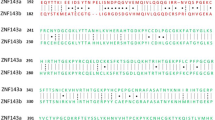Abstract
During the process of screening genes that are preferentially expressed in zebrafish germ cells, we isolated an E2F family member zE2F5b, which is a truncated isoform of zebrafish E2F5a. The E2F transcription factors are thought to play an essential role in cell cycle progression. Reverse transcription polymerase chain reaction and whole mount in situ hybridization analyses have demonstrated that both zE2F5a and zE2F5b mRNAs are predominantly expressed in stage I and II oocytes. In early development, the two zE2F5 transcripts are expressed by many parts of the embryo and are then restricted to the brain area. Interestingly, zE2F5b mRNA is detected later in the lens and optic tectum while zE2F5a mRNA is absent. Our data suggests that E2F5 may play important roles in zebrafish brain, eye and ovarian development.







Similar content being viewed by others
References
Bin L, Gang W, Hu J, Gong W, Yue M, Song P (2007) Identification and characterization of TSAP, a novel gene specifically expressed in testis during spermatogenesis. Mol Reprod Dev 74:1141–1148
Mo S, Song P, Lv D, Chen Y, Zhou W, Gong W, Zhu Z (2005) Zebrafish z-otu, a novel Otu and Tudor domain-containing gene, is expressed in early stages of oogenesis and embryogenesis. Biochim Biophys Acta 1732:1–7
Zhou W, Song P (2006) Molecular cloning of a novel gene ZAhi-1 and its expression analysis during zebrafish gametogenesis. Mol Biol Rep 33:111–116
Rowland BD, Bernards R (2006) Re-evaluating cell-cycle regulation by E2Fs. Cell 127:871–874
Chen Q, Liang D, Overbeek PA (2008) Overexpression of E2F5/p130, but not E2F5 alone, can inhibit E2F-induced cell cycle entry in transgenic mice. Mol Vis 14:602–614
Trimarchi JM, Lees JA (2002) Sibling rivalry in the E2F family. Nat Rev Mol Cell Biol 3:11–20
Lindeman GJ, Dagnino L, Gaubatz S, Xu Y, Bronson RT, Warren HB, Livingston DM (1998) A specific, nonproliferative role for E2F–5 in choroid plexus function revealed by gene targeting. Genes Dev 12:1092–1098
Phillips AC, Vousden KH (2001) E2F-1 induced apoptosis. Apoptosis 6:173–182
Suzuki A, Hemmati-Brivanlou A (2000) Xenopus embryonic E2F is required for the formation of ventral and posterior cell fates during early embryogenesis. Mol Cell 5:217–229
Pohlers M, Truss M, Frede U, Scholz A, Strehle M, Kuban RJ, Hoffmann B, Morkel M, Birchmeier C, Hagemeier C (2005) A role for E2F6 in the restriction of male-germ-cell-specific gene expression. Curr Biol 15:1051–1057
Wu Q, Krainer AR (1999) AT-AC pre-mRNA splicing mechanisms and conservation of minor introns in voltage-gated ion channel genes. Mol Cell Biol 19:3225–3236
Vaishnav YN, Vaishnav MY, Pant V (1998) The molecular and functional characterization of E2F-5 transcription factor. Biochem Biophys Res Commun 242:586–592
Black EP, Hallstrom T, Dressman HK, West M, Nevins JR (2005) Distinctions in the specificity of E2F function revealed by gene expression signatures. Proc Natl Acad Sci USA 102:15948–15953
Hallstrom TC, Nevins JR (2003) Specificity in the activation and control of transcription factor E2F-dependent apoptosis. Proc Natl Acad Sci USA 100:10848–10853
de Bruin A, Maiti B, Jakoi L, Timmers C, Buerki R, Leone G (2003) Identification and characterization of E2F7, a novel mammalian E2F family member capable of blocking cellular proliferation. J Biol Chem 278:42041–42049
Selman K, Wallace RA, Sarka A, Qi X (1993) Stages of oocyte development in the zebrafish, Brachydanio rerio. J Morphol 218:203–224
Kusek JC, Greene RM, Nugent P, Pisano MM (2000) Expression of the E2F family of transcription factors during murine development. Int J Dev Biol 44:267–277
Palena A, Mangiacasale R, Magnano AR, Barberi L, Giordano R, Spadafora C, Lavia P (2000) E2F transcription factors are differentially expressed in murine gametes and early embryos. Mech Dev 97:211–215
Rempel RE, Saenz-Robles MT, Storms R, Morham S, Ishida S, Engel A, Jakoi L, Melhem MF, Pipas JM, Smith C, Nevins JR (2000) Loss of E2F4 activity leads to abnormal development of multiple cellular lineages. Mol Cell 6:293–306
Draper BW, McCallum CM, Moens CB (2007) nanos1 is required to maintain oocyte production in adult zebrafish. Dev Biol 305:589–598
Myster DL, Bonnette PC, Duronio RJ (2000) A role for the DP subunit of the E2F transcription factor in axis determination during Drosophila oogenesis. Development 127:3249–3261
Chi W, Reinke V (2006) Promotion of oogenesis and embryogenesis in the C. elegans gonad by EFL-1/DPL-1 (E2F) does not require LIN-35 (pRB). Development 133:3147–3157
Westerfield M (2000) The zebrafish book. A guide for the laboratory use of zebrafish (Danio rerio), 4th edn. University of Oregon Press, Eugene
Kimmel CB, Ballard WW, Kimmel SR, Ullmann B, Schilling TF (1995) Stages of embryonic development of the zebrafish. Dev Dyn 203:253–310
Jowett T (2001) Double in situ hybridization techniques in zebrafish. Methods 23:345–358
Acknowledgments
This study was supported by the National Basic Research Program of China (grand No. 2004CB117400) and the National Natural Science Foundation of China [grand No. 30150005; No. 30270675 (P. Song)].
Author information
Authors and Affiliations
Corresponding authors
Rights and permissions
About this article
Cite this article
Yang, Q., Hu, J., Ye, D. et al. Identification and expression analysis of two zebrafish E2F5 genes during oogenesis and development. Mol Biol Rep 37, 1773–1780 (2010). https://doi.org/10.1007/s11033-009-9605-4
Received:
Accepted:
Published:
Issue Date:
DOI: https://doi.org/10.1007/s11033-009-9605-4




